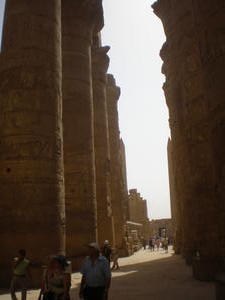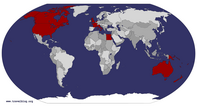Advertisement
Published: November 5th 2008

 Temple at Karnak
Temple at Karnak
What do you say it's jawdroppingly immense and impressiveThis time it's the difference between the world of backpackers' hostels and the world of the luxury hotel, where your room is cleaned three times a day, fresh sheets are put onto your bed daily and clean towels are offered about three times a day: the cruising classes must be a mucky lot.
It transpired that our sleeper train left from Giza not Cairo itself, which meant another hair-raising taxi trip. After being security searched, we hung around on the platform waiting for sleeper train number 82, which duly arrived. It consisted entirely of sleeper cars and was British Rail style circa 1965 - a little compartment for the two of us, with a wash basin and two bunks. Dinner was awful - come back British Rail, all is forgiven. As it was after nightfall when we left Cairo, we saw nothing of the Nile on the way to Luxor and at 10pm, our attendant lowered the bunks and we went to bed. I slept reasonably well, but Willy, who can fall asleep within 10 minutes as a car passenger and slept daily on the train from Glasgow to Linlithgow for almost 20 years, found the challenge of sleeping while
lying down and travelling sideways was just too much and lay awake till the early hours. We were woken by the attendant at 5am and arived at Luxor at 6.30.
At Luxor, we were met by a guide who took us by taxi to the SS Esadora, our new home. The cruise boats were moored in packs three and four deep at the quayside, so we had to walk through a couple of boats before we got there. She's run by an Italian travel company, so all info in the boat was in Italian and the staff assumed you could speak it.
I think that because the boat wasn't actually full, spare places had been made available to other travel agents and we'd got a couple of these. Initially there was some confusion about who was to be our guide and when he would arrive, so we dumped our day sacks in our cabin, (a bit of a contrast to the vast suitcases being brought onto the boat by porters) and went out to see Luxor.
On our travels, we found a rooftop internet cafe, with very reasonable rates and decent coffee, so spent an hour checking
emails and beginning our Egypt blog.
Now I'll lower the tone and talk about toilet habits in the Arab world. Toilet paper is not always provided, but fortunately I carry a packet of tissues with me. What is provided is water-based: either a hosepipe thing or a nozzle in the back of the toilet. On the wall is a tap. I tried it out of curiousity, and discovered that it's very easy to flood both the cubicle and your clothes.
Now back to the world of cruise liners. We returned to the boat and met our guide who took us to visit both Karnak and Luxor temples.
We lunched alone, on a table at the other side of the dining room from the Italians, having been rigidly segregated on national lines by the waiters.
After lunch, we visited three tombs in the Valley of the Kings, the temple of Hatchepsut, and the statues of Agamemnon, though I'm not sure why Agamemnon was in Egypt. (Co-Author's Note: he wasn't. It was built by one of the Ptolemies who were of Greek descent)
Willy was still recovering from his
cold and was exhausted, so we skipped the chance to visit an alabaster factory cum shop suggested by our guide and returned to the boat for afternoon tea and a kip. We watched the sunset over Nile and saw a couple of black kites.
At dinner we found the rest of our "group" had arrived: Peter, Yelena Tony and Mina, all from London, but with interesting pedigrees covering a fair bit of the world between them.
By Tuesday, I'd gone down with a sore throat and head, so spent the day sitting beside the open floor to ceiling window in the cabin watching life go by on the Nile banks as it has done for centuries. It seemed almost biblical: and at the same time like watching a geography text book float past before your eyes. Sugar cane, shadufs, camels, donkeys and men in flowing robes, irrigation canals and women washing clothes in the Nile. Our guide told us later that farmers use new methods, like tractors and bumping machines. (after a while it dawned on me that Egyptians don't differentiate between "b" and "p" and he actually meant "pumping machines").
I was still a bit iffy
on Wednesday, but the visits were only short, so I made it to Edfu and Komombo temples and slept a lot in between times. When we arrived in Aswan, the Brits went for a walk to the market. All we purchased was coloured peppercorns.
Aswan's a lovely place, a much nicer town than Luxor - and the drivers obey traffic lights.
On Thursday we visited the Aswan dam and the Aswan High Dam - the photos will give some stats and an impression of just how vast it is. We drove across the old Aswan Dam and visited the High Dam, which was a tremendous project undertaken with Russian aid. It meant the displacement of 40,000 Nubians and moving of several large temples, as the area flooded to create Lake Nasser and control the flood waters of the Nile is aboit 500km by 20 or so km : the largest man made lake in the world. (starting to sound like a Geography text book again!).
Next we went by motor boat to the island in Lake Nasser to which Philae Temple was moved, stone by stone, to prevent it being swamped by the rising waters once the
dam was completed. It's a beautiful setting, spoiled only be being mobbed by hundreds of tourists all at once. Queues for the ladies toilets were as ever very long, but the attendant speeded throughput by directing us into the gents, where gents were freely using the urinals. Getting back to dry land was a bit fraught: having unloaded us on the outward journey, the boats go away from the quay and moor beside another island where there's a bit more space. Our guide shouted "Abdullah", feebly for about 15 minutes before Abdullah appeared to ferry us back to shore. Lake Nasser itself is home to many birds: we saw herons, egrets and some variety of duck we didn't recognise.
On the way back to the boat, we stopped at a perfume factory to learn about essential oils, and be sold them. We resisted the temptation, though it was interesting to see. Next on to the quarries to see an obelisk, which was left in place when a flaw appeared in the face. This was much less touristy - and the guides didn't accompany their groups, which meant you didn't get herds of people moving in unison. One of the
soldiers guarding this strategic site invited us through the retaining rope to see the obelisk more clearly and Peter (our Londoner) and I had a bash (literally) at completing the quarrying. All I can say is it was bloody hard work as the only tool availablre was a roughly shaped stone hammer of harder stone (dolomite according to our soldier friend).
In the afternoon, we were promised a felucca ride to Kitchener's Island, where he had built a tropical garden. It was too windy for a felucca, so we used a motor boat instead and on the way back, we saw a capsized felucca being attended to by a Police boat. Kitchener's island is a little neglected, but still an oasis of green, with interesting palm trees and other vegetation - and schoolkids by the dozen all wanting to say hello and ask your name, which is really quite nice, until their teachers spoil it by shouting at them for disturbing us.
Later in the afternoon, we ventured guide free and on foot to the Nubian museum, which is a beautiful clean place, made of pink granite. It's impressive as a building and the exhibits are interesting and
well laid out, in a chronological sequence, with plenty of space between them and with clear labels. Here again we were accosted by friendly school girls, who all wanted to say hello and ask "what's your name?" and "where are you from?". This time their teacher joined in, which was really nice.
We were waiting for the rest of our group outside and Willy was having a fag, when a couple of families came out and sat beside us on the wall. They said they spoke no English and asked if we spoke arabic, so I demonstrated the full extent of my command of arabic: "hello", "please", " thank you" and the numbers from 1 to 10, apart from 8, which I just can't seem to get into my head. They made us feel very welcome.
Back to the boat in time for dinner and a Nubian evening, which consisted of one folk dance, which was very good, the all the Brits being dragged up to dance, while the Italians left the bar as fast as they could. Then a second dance, where a witch doctor guy insisted that you be dragged up to dance again. Having already
been dancing for about 10 minutes, I refused and ended up having to scream "No!" at him about 7 times and fold my arms before he left me alone. He was really quite agggressive and insistent and made me feel thoroughly uneasy. All the other British women were reluctantly dragged to their feet, but he seemed to understand that "No" meant "no" when a man said it: they weren't hassled nearly as much.
On Friday both Willy and Yelena have upset stomachs and are reclining on the sun deck, so I'm taking the opportunity to do some blogging.
We threw some flowers into the Nile and said a few words in memory of Robin today.
We leave the boat tonight and take the 14 hour train trip back to Cairo.
We hope to visit the pyramid in Giza tomorrow, if we manage to sleep on the train and if Willy's recovered from his food posioning.
Then we're hoping for a couple of days in Alexandria before flying back next week: we're both ready to be home now.
Advertisement
Tot: 0.117s; Tpl: 0.014s; cc: 13; qc: 32; dbt: 0.0838s; 1; m:domysql w:travelblog (10.17.0.13); sld: 1;
; mem: 1.1mb
























